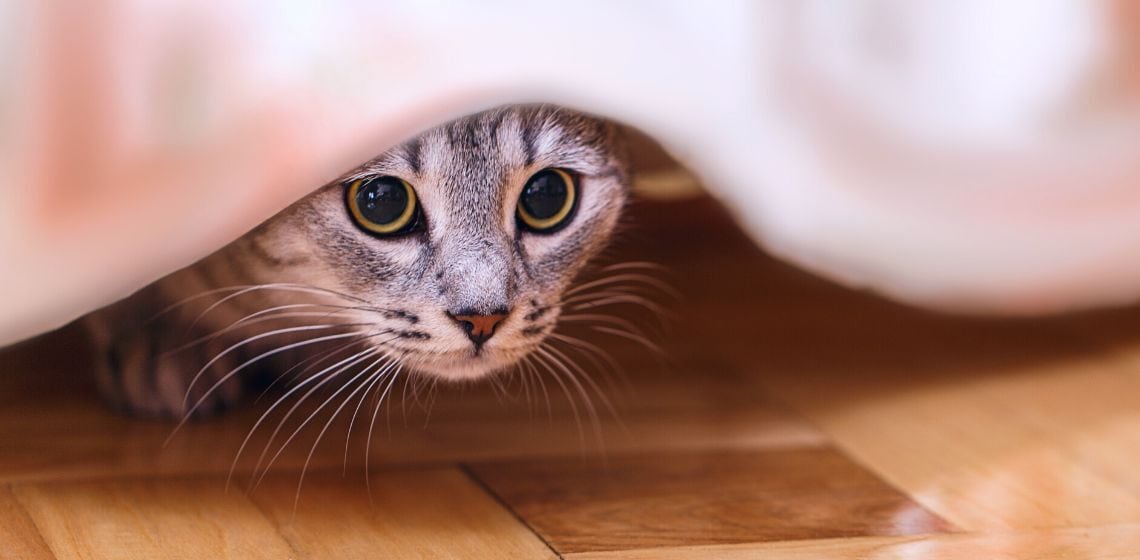Table of Contents
What is Anxiety in Cats?
Anxiety is a common issue among our feline companions that often goes unrecognized or misunderstood. Anxiety can be defined as a feeling of unease, such as worry or fear, that can be mild or severe. In cats, it may manifest as a response to perceived threats or unfamiliar situations, impacting their behavior and overall well-being.
Causes of Cat Anxiety
Anxiety in cats can stem from various factors, including environmental, medical, or genetic predispositions. Environmental factors such as changes in the household (new pets, people, or furniture), loud noises, or unpredictable routines can trigger anxiety.
Medical factors, like pain or illness, hormonal imbalances, or neurological disorders, can also contribute to anxiety in cats. Certain cats may be more prone to anxiety due to their breed, genetic makeup, or individual temperament.
In addition, interactions between cats in multi-cat households can play a large role in feline anxiety. Separation anxiety is another potential cause.
Anxiety can be generalized (present all the time and affecting day-to-day life) or situational (arising only in certain situations such as riding in a car, vet visits, fireworks, etc.).
Cat Anxiety Symptoms
Cats can experience anxiety just like humans, but they express it differently. Common signs and symptoms of anxiety in cats include:
- Hiding or avoiding social interaction
- Excessive grooming or hair loss
- Aggression or irritability
- Changes in activity level and sleep schedule
- Restlessness, or inability to settle
- Inappropriate elimination (urinating or defecating outside the litter box)
- Changes in appetite or weight
- Changes in body language
It is crucial to consult a veterinarian for proper diagnosis, as some of these symptoms may also be indicative of underlying medical issues.
Diagnosing Anxiety in Cats
It is always important to rule out medical causes of your cat’s symptoms before attributing them to anxiety. Therefore, a veterinary exam and diagnostics are the best places to start.
- History – Your detailed description of behaviors and triggers that you have noticed at home will be incredibly helpful for your vet.
- Physical exam – A nose-to-tail physical exam is the first step.
- Bloodwork, including thyroid – Bloodwork will help your vet evaluate your cat’s overall systemic health and major organ function.
- Urinalysis – One common presentation of anxiety is urinating outside of the litter box, so your vet will want to check a urine sample for evidence of urinary tract infection or other abnormalities.
- Imaging – X-rays and/or an ultrasound may be recommended in some cases to evaluate your cat’s lungs, abdomen, and musculoskeletal system.
- Other – Additional testing may be recommended depending on your cat’s results.
How to Treat & Prevent Anxiety in Cats
In order to manage anxiety in your cat, you may have to utilize several techniques. By combining these strategies, pet parents can help their feline companions overcome anxiety and improve their overall well-being. It is always recommended to consult with a veterinarian or feline behaviorist for professional guidance and support when addressing anxiety in cats.
Medication
In some cases, your vet may recommend prescription anxiety medication. This may be a long-term medication such as fluoxetine (Prozac) or short-acting drugs such as gabapentin that can be given before an anxiety-producing event. There are numerous medications available, and your vet or veterinary behaviorist will use their expertise to help choose the best option for your cat.
Supplements and Calming Aids
Over-the-counter supplements such as Composure Chews or pheromone sprays and diffusers can often be helpful in reducing anxiety levels in your cat.
Environmental Modification and Enrichment
Even some minor changes to your cat’s environment can help decrease stress. See the Indoor Pet Initiative for more tips on stress reduction and enrichment in cats.
- Consider your litter box – Make sure that you have the correct number of litter boxes, a substrate that your cat approves of, they are cleaned frequently, and that the litter boxes are in locations that feel safe and easily accessible for your cat.
- Provide basic resources – All cats will require food, water, a litter box, a resting area, a scratching area, and toys. Make sure that you provide enough resource stations throughout your house so that there is no competition for these basic needs amongst your cats.
- Provide safe spaces and hiding spaces – Create cozy areas throughout your home using cat beds, boxes, or even blankets to allow your cat to retreat. Cats also love to perch and observe from high areas.
- Enrich the environment – Offer toys, a scratching post, and window perches to keep your cat engaged, mentally stimulated, and physically active. Cats need an outlet for their natural hunting instincts, so food toys like this one can be especially beneficial.
Behavioral Intervention
Behavioral intervention and training can be extremely helpful once you have identified your cat’s anxiety triggers.
Positive reinforcement and counter-conditioning techniques – Reward your cat with treats, praise, or affection when they exhibit calm behavior or interacts positively with potential stressors.
Gradual desensitization to stressors – Expose your cat to anxiety-inducing stimuli at a low intensity, gradually increasing the intensity while providing positive reinforcement.
Consult with a board-certified veterinary behaviorist – Seek expert advice to develop a customized behavior modification plan tailored to your cat’s specific needs and triggers.
Depending on the cause and severity of your cat’s anxiety, you may be able to work with your vet or a veterinary behaviorist to come up with a treatment plan involving medications, behavioral interventions (such as desensitization and counter-conditioning), enrichment, and environmental modification (making changes to your home). Mild cases may respond to environmental changes alone or over-the-counter options such as Composure Chews and Feliway. If your cat has certain triggers, such as a visit to the vet or fear of fireworks, you may be able to give them a short-acting medication ahead of time to ease anxiety. In general, if your cat is showing signs of anxiety, it is best to give them space and remove any obvious triggers, loud noises, and other animals from the room. However, be aware that certain medical conditions can cause similar symptoms to anxiety, so do not delay needed veterinary care.
Our feline family members can be sensitive souls with numerous triggers for anxiety. Of course, a lot will depend on your individual cat, including its age, temperament, history, environment, and any underlying medical conditions. Anxiety can be generalized (present all the time and affecting day-to-day life) or situational (arising only in certain situations such as riding in a car, vet visits, fireworks, etc.). Common triggers for anxiety in cats include any change in routine. This may be large changes such as moving houses or the arrival of a new human or furry family member. Or it may be something relatively minor such as remodeling a room, getting new furniture, or having guests over. Once you are aware of your cat’s individual triggers, you will be able to help keep them calm with medications or environmental modification ahead of time. Interactions between cats in multi-cat households can also play a big role in feline anxiety.
Cat anxiety is very common and can present in many different ways, such as urinating outside the litter box or fear-based aggression. Whether it’s occasional and mild or generalized anxiety affecting your cat’s day-to-day life, your vet is there to help.

Liza is a veterinarian who graduated from MSU CVM in 2013 and spent five years working in small animal practice. She loved working with dogs and cats and educating owners on all aspects of veterinary medicine, especially animal behavior and dermatology. She has since transitioned to remote work to be able to spend more time at home with her husband, two young kids, and two cats. She is thrilled to be able to combine her passions for veterinary medicine and writing. She is licensed as a veterinarian in Washington State.








